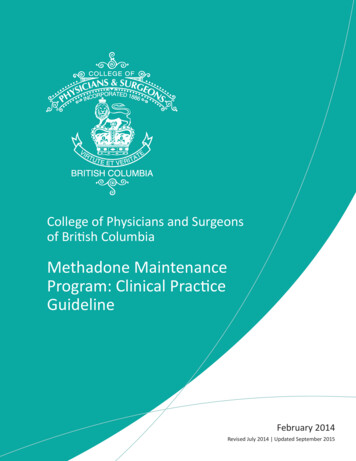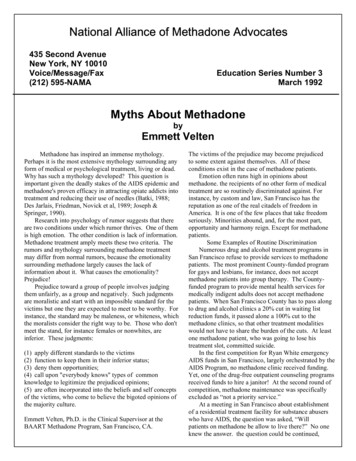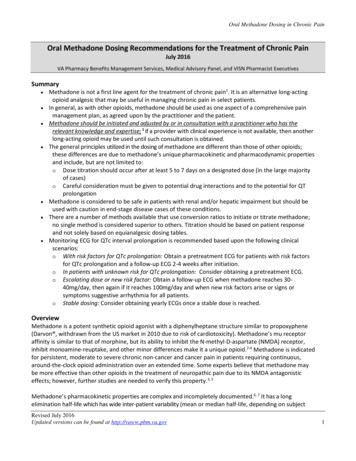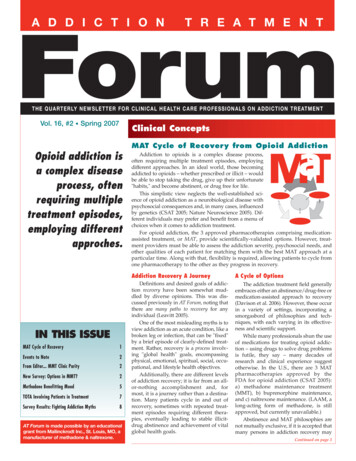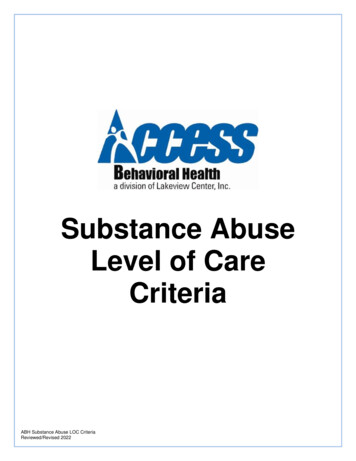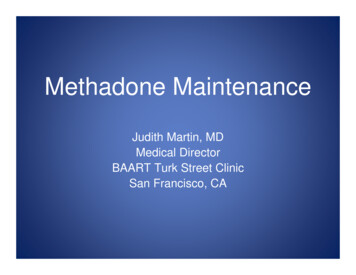
Transcription
Methadone MaintenanceJudith Martin, MDMedical DirectorBAART Turk Street ClinicSan Francisco, CA
Dr. Martin, Disclosures No conflict of interest to disclose. No discussion of off-label use. Special thanks to Dr. Thomas Payte forallowing me to use some of his greatslides.
Physicians Working in MMTWill Know: How to safely induce patients to MMT. How to adjust methadone dosing formaximum effectiveness. How to detect and manage MMT sideeffects and medication interactions. How to work within legal/regulatoryframework of 42 CFR part 8.
Safety Considerations in MMT: Avoid sedation and respiratory depression(stay within tolerance) Minimize side effects of constipation,sweating, hypogonadism Alertness to potential medicationinteractions, QT/cardiac risk Minimize diversion, accidental ingestion ordosing errors
Safe Induction:“Start Low go Slow” Methadone-related deaths during MMToccur during the first 10 days of treatmentand are more common with higherinduction doses. There is no way of directly measuringtolerance to methadone. Estimate ofopioid tolerance is based on history andphysical, supported by toxicology tests.
Methadone Deaths in Treatment Induction risk 7 times greater than activeheroin use. Methadone induces its ownmetabolic rate over time. Eventual doseneeded will be usually much higher thaninitial tolerance. Most deaths also show benzodiazepineson toxicology. This is true of mostunintentional opiate poisonings.
Methadone is an Unusual Opioid: Slow onset of action: patient starts to ‘feel’ theswallowed dose 30-45 minutes later. Delayed peak action: greatest effect from singledose is 2-4 hours post ingestion. Tissue stores: methadone deposited in tissue over3-7 days to reach steady state. This means thatduring induction, a given dose will have strongereffect and last longer with each day of ingestion.
Steady State: The point at which during each interdose interval therise and fall of drug concentration for the interdose interval isidentical for each dose(Slide courtesy of Dr. Thomas /Half-Lives – Methadone half-life 24-36 hoursDose constant at 30 mg daily. Interdose interval 24 hrs (trough to trough)Peak levels increase daily for 5-6 days with NO increase in dose!Note: This slide was developed by Dr. Payte to illustrate that it takes several days to know the full effect of agiven dose at steady state. It shows one patient’s blood levels during induction, at a dose of 30mg. Themaximum effect rises with each dose, even though the amount administered to the patient remains the sameeach day.
Clinical Pointers in Choosing Initial Dose: Special caution if: Patient inexperienced with methadone Patient uses benzodiazepines or alcohol Recent abstinence history (example:incarceration) Unable to observe patient for several hours afterfirst dose. Unable to document use or withdrawal onphysical examNote: There is wide variation in metabolism of methadone, and no blood level or dose that is ‘therapeutic’ for all patients. Patients who are onlyfamiliar with short-acting opiates might expect full effect of dose within an hour after taking a dose of methadone, and when they don’t feelrelief, add illicit drugs to relieve withdrawal, thus overdosing. Benzodiazepines and alcohol have synergistic sedative effect with methadone,and may cause dangerous sedation or respiratory depression when used with methadone (or other opiates). Tolerance fades when patientsare abstinent, for example when they have been in residential programs, or in jail. Also, if the patient has not used opiates in several days anddoes not have signs of withdrawal, low tolerance should be assumed at induction. Some settings do not offer observation at peak of doseeffect, so patients are only seen after dose effect is wearing off. Patient may be in withdrawal 24 hours after an adequate dose because tissuestores have not built up. In this case interview patient about effects at peak, or call on the phone at peak, when trying to adjust the dose duringinduction. Patients may misrepresent their history. Usually use of needles can be documented on the physical, withdrawal signs, such aspupillary dilation, can be found on physical, and on-site dipstick toxicology tests can support the history of opioid use.
First Dose Limited in Regulation,42 CFR Part 8.12 Maximum first dose is limited to 30mg. Maximum total dose during first day oftreatment is 40mg.Note: Patients estimated to have high tolerance, for example a history of daily use of 3gm of heroin by injection for a year, withmany track marks in different stages of healing, physical signs of withdrawal, and a history of previous MMT(ie patient familiarwith methadone effects), would probably benefit from maximum dose, with evaluation for additional dose increases over the firstseveral days. Many patients need lower than maximum dose, for example a patient naïve to methadone treatment who has usedhydrocodone tablets for six months and does not have dilated pupils at admission may benefit from a starting dose of 10mgfollowed by observation.
Induction, Summary. Tension between efficacy/safety during induction,safety prevails. Tolerance can only be estimated, special care withlow potency opioid abusers. Start low, go slow until steady state achieved. Prescription drug abusers are sometimes used togetting their drugs of abuse from doctors like you!
Efficacy Considerations in MMT: Relief of physical withdrawalRelief of cravingBlocking doseStability throughout the day (allowsnormalization of body and mind) Engagement in recovery and personalgrowth activities
Effective Maintenance Dose: Opioid withdrawal symptoms and signs, includingcraving are controlled during the entire 24 hoursbetween doses of methadone. Patient is alert, aware of his or her surroundings,able to study, work, carry out family obligations,make progress in treatment goals. Illicit opioids are usually not ‘felt’ if use occurs. Average maintenance doses in US: 60120mg/day.
Dose ResponseMethadone Simulated 24 Hr. Dose/ResponseAt steady-state in tolerant patient“Loaded”“High”“Abnormal Normality”Normal Range“Comfort Zone”Subjective“Sick”w/dObjective w/d0hrs.TimeOpioid Agonist Treatment of Addiction - Payte - 199824hrs.Note: This slide contrasts the rapid impact and fleeting effect of injected or inhaled heroin (blue curve) with steady-state methadone maintenance atthe correct dose. The patient is neither intoxicated (loaded) nor in withdrawal (sick). Highest and lowest effect of methadone daily dose are both withinthat normal range that allows clear thought and action. In early treatment, patients may not be comfortable in the alertness range: they haveconditioned themselves to fear alertness, because it indicates impending withdrawal. Dr. Payte indicates this by the ‘abnormal normality’ box: patientsfeel most comfortable when they are not completely alert, and may need education about the long-acting properties of MMT.
Recent Heroin Use by CurrentMethadone Dose% Heroin Use1008060402000102030405060708090 100Methadone Dose, in mg.Ref: J. C. Ball, November 18, 1988 Slide adapted from Tom PayteNote: This shows dose-effectiveness in MMT: doses over 60 are frequently required to achieve abstinence from heroin.
Reinstating TreatmentAfter Absence: Stability is a goal in treatment, missingdays undermines benefits of MMT Medical evaluation after absence isusually a ‘safety to dose’ evaluation: Has the patient been in the hospital or ED?Has the patient been incarcerated?Was it a ‘binge’, for example cocaine oralcohol relapse?Is the patient alert? Are there newmedications?
When Does ToleranceWear Off? Overdose risk high after incarceration Overdose risk after naltrexone treatment Overdose risk after detoxification (Stranget al, BMJ 2003;326:959–60) is greater forthe ‘successfully treated’, ie abstinent.
Reinstating TreatmentAfter Absence: Continued What are the difficulties with daily attendance? Has the patient lost tolerance? Loss of tolerancehas been reported at 3 weeks. In general big jumps in dose are notrecommended, undermine stability. Usually after 3-5 days, dose is lowered and thengradually increased to the regular dose.
Reinduction ParametersAfter Absence Programs usually have guidelines about reinduction after absence. (low level of evidence: protocols vary, nocontrolled studies) Example: absence less than 21 days: re-inducestarting at 30mg BUT buildup to regular dose atfaster rate than intake. Re-induce as a newpatient, after 21 days absence.
Should MMT Ever be Discontinued? Opioid addiction is a chronic, relapsingcondition, so long-term treatment isindicated. Prognosis after withdrawal from MMT isdismal: most patients relapse before 12mos. (compare this to diabetes,hypertension, epilepsy, etc. – otherchronic conditions that require ongoingmedication)
Relapse to IV Drug Use After MMT105 Male Patients who Left Treatment10082.1Percent IV Users8072.26057.645.54028.9200IN1 to 3Treatment4 to 67 to 910 to 12Months Since StoppingTreatmentAdapted from Ball & Ross - The Effectiveness of Methadone Maintenance Treatment, 1991Opioid Agonist Treatment of Addiction - Payte - 1998Note: When patients taper off of methadone maintenance, relapse is almost universal. There is no way to predictwho are the 18% of patients who will not relapse within a year. During medically supervised withdrawal, closeobservation and keeping open the possibility of resuming therapeutic doses promptly is indicated.
Treatment Outcome Data:Methadone Maintenance 4-5 fold reduction in death ratereduction of drug usereduction of criminal activityengagement in socially productive rolesreduced spread of HIVexcellent retention (see: Joseph et al, 2000, Mt. Sinai J.Med., vol 67, # 5, 6)
Crime Among 491 Patients Before andDuring MMT at 6 ProgramsCrime Days Per Year300250200Before TXDuring TX150100500ABCDEFAdapted from Ball & Ross - The Effectiveness of Methadone Maintenance Treatment, 1991Opioid Agonist Treatment of Addiction - Payte - 1998Note: This shows criminal activity at six different methadone maintenance programs, comparing rates beforetreatment (pink) to during treatment (yellow).
HIV Conversion In Treatment35%30%25%20%ITOT15%10%5%0%Base line6 Month12 Month18 MonthHIV infection rates by baseline treatment status. In treatment (IT) n 138, not intreatment (OT) n 88Source: Metzger, D. et. al. J of AIDS 6:1993. p.1052Opioid Maintenance Pharmacotherapy - A Course for Clinicians - 1997Note: This slide shows protection from HIV sero-conversion by enrollment in MMT: the longer the treatmentthe more relative protection from HIV.
Special Populations and MMT PregnancyChronic painPolysubstance useNeedle related chronic conditions: HIV andHepatitis
Pregnancy MAT treatment of choice for pregnant, opioidabusing women. Efforts to avoid intra-uterine fetal withdrawal. May require divided doses because of alteredmetabolism. Neonatal withdrawal occurs within 72 hours, not allinfants need treatment. Breastfeeding recommended if not HIV positive.
Pain in Patients on MMT Single daily dose as used in MMT does not controlchronic pain. Analgesic effect is 8-12 hours. Up to 60% of MMT patients have chronic pain(Jamison 2000, Rosenblum 2003) If patient meets criteria for take-homes, considerdivided doses for enhanced pain control. (Seconddaily dose usually counted as a ‘take-home’ dose).
Polysubstance Use: If patient has reduced or eliminated illicitopiate/needle use in MAT, very few indications fordischarge. Sedative use (benzodiazepines/alcohol) maybecome a safety issue, require lower or with-helddoses and reduce effectiveness of treatment. Stimulant use is usually a retention issue: patienthas many missed days, arrested, etc.
Medication Interactions: Methadone effects change when bloodlevels change. Inactive metabolite, so metabolismsensitive (liver enzymes) CYP 350 In general, changes in dose aredetermined clinically, when symptom/signsappear after new medications added orwithdrawn.
Medication Interactions, SpecialAttention: Monitor Patient Anticonvulsants (dilantin, phenobarbital)HIV medication (efavirenz)RifampicinQT prolonging drugs (antipsychotics)Lots of others!
Regulations and MMT: Diagnosis of opioid dependence(addiction) required First day dosing limited in regulation Restriction of unobserved doses Specially licensed facility, accreditingstandards. Diversion control plan Mandated testing and counselingNote: Methadone maintenance programs have a DEA license and an approved DEA safe for storing methadone.There are medication reconciliation standards as well as clinical care standards. Some of the regulation isspecifically therapeutic for the patient, some of the regulation protects the community from diversion of apotentially deadly schedule 2 narcotic. Physicians working in methadone clinics find themselves involved in both.Clinical decision is limited and documentation requirements are high.
Note: Observed dosing is required by Federal regulation. Nurse orpharmacist observe dose. Diversion control plan usually calls forliquid doses with added water, speaking before and after dosing toavoid ‘cheeking’ and diverting dose.THE DOSING WINDOW
What About Take-homes? 8 criteria for takehomes defined in 42CFR part 8. In general, patients with positive toxicology do notqualify, homeless or unemployed patients do notqualify, patients who do not comply withcounseling, or who miss doses do not qualify. Take homes are gradually built up from one perweek to monthly. Physicians are often involved in ‘exception’ takehome decisions.Note: The famous ‘eight points’ that must be considered for takehomes are: (i) Absence of recent abuse of drugs(opioid or nonnarcotic), including alcohol; (ii) Regularity of clinic attendance; (iii) Absence of serious behavioral problems at theclinic; (iv) Absence of known recent criminal activity, e.g., drug dealing; (v) Stability of the patient’s home environment and socialrelationships; (vi) Length of time in comprehensive maintenance treatment; (vii) Assurance that take-home medication can besafely stored within the patient’s home; and (viii) Whether the rehabilitative benefit the patient derived from decreasing thefrequency of clinic attendance outweighs the potential risks of diversion.
Exception Take-homesRequire Approval: Physician has to certify that patient meetsthe eight points of regulation Approval from CSAT typically hascontingency statements, for example nobenzo use, etc.
Examples of Patients who mayNeed Exception Take-homes: Patients in residential treatment Patients on dialysis Patients dependent on oxygen, portabletanks are small Patients in wheelchair, or with difficultyambulating Patients with rapid metabolism requiringmore than one daily dose
Review Learning Objectives:Physicians Working in MMT will know: How to safely induce patients to MMT. How to adjust methadone dosing formaximum effectiveness. How to detect and manage MMT sideeffects and medication interactions. How to work within legal/regulatoryframework of 42 CFR part 8.
Please Click the Link Below toAccess the Post Test for theOnline ModuleUpon completion of the Post Test: You will receive an email detailing correct answers,explanations and references for each question. You will be directed to a module evaluation, uponcompletion of which you will be emailed your moduleCertificate of Completion.http://www.cvent.com/d/tcqq8p
Clinical Pointers in Choosing Initial Dose: Special caution if: Patient inexperienced with methadone Patient uses benzodiazepines or alcohol Recent abstinence history (example: incarceration) Unable to observe patient for several hours after first dose. Unable to document use or withdrawal on physical exam Note: There is wide variation in metabolism of methadone, and no .

